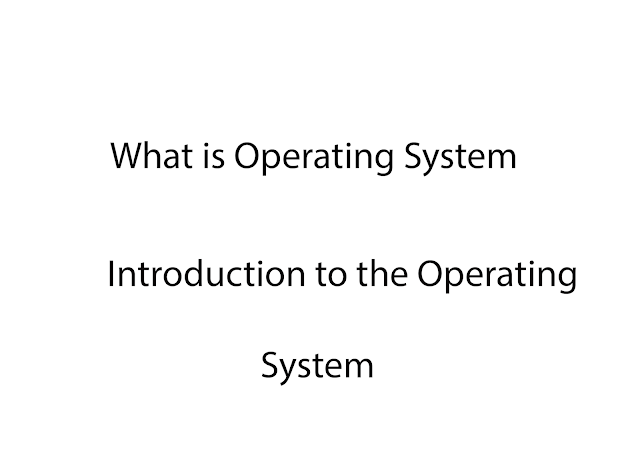What is Operating System? an introduction to Operating System
Introduction:
An Operating System goes about as a delegate between the user of a PC and PC equipment or Hardware. The reason for the operating system is to give a climate where a client can execute programs in a helpful and proficient way.
An operating system is programming that oversees PC Hardware. The equipment should give fitting instruments to guarantee the right activity of the PC situation and to forestall client programs from meddling with the appropriate activity of the framework.
Operating System – Definition:
An Operating System is a program that controls the execution of use projects and goes about as an interface between the client of a PC and the PC equipment.
A more normal definition is that the operating system is the one program running consistently on the PC (for the most part called the piece), with all else being application programs.
An operating system is worried about the designation of assets and administrations, like memory, processors, gadgets, and data. The operating system correspondingly incorporates projects to deal with these assets, like a traffic regulator, a scheduler, a memory the board module, I/O programs, and a record framework.
Elements of Operating framework – Operating framework performs three capacities:
In An operating system programming plays out every one of the capacity:
Interaction the executives:-
Process the board assists OS with making and erase measures. It likewise gives instruments to synchronization and correspondence among measures.
Memory the executives:-
Memory the board module plays out the errand of portion and de-assignment of memory space to programs needing this asset.
Record the board:-
It deals with all the document-related exercises like association stockpiling, recovery, naming, sharing, and insurance of records.
Hardware Management:
Device the executives keeps tracks, everything being equal. This module likewise liable for this errand is known as the I/O regulator. It additionally plays out the errand of assignment and de-portion of the gadgets.
I/O System Management:
One of the fundamental objects of any OS is to conceal the idiosyncrasies of that equipment gadget from the client.
Auxiliary Storage Management:
Systems have a few degrees of capacity which incorporate essential stockpiling, optional capacity, and reserve stockpiling. Guidelines and information should be put away in essential stockpiling or store with the goal that a running project can reference it.
Security:-
Security module ensures the information and data of a PC framework against malware danger and approved admittance.
Order translation:
This module is deciphering orders given by the and acting framework assets to handle that orders.
Systems administration:
A circulated framework is a gathering of processors which don't share a memory, equipment gadgets, or a clock. The processors speak with each other through the organization.
Occupation bookkeeping:
Keeping track of time and assets utilized by different work and clients.
Correspondence to the executives:
Coordination and task of compilers, mediators, and another product asset of the different clients of the PC frameworks.
Highlights of Operating System (OS)
Here is a rundown significant highlight of OS:
Ensured and administrator mode
Permits circle access and document frameworks Device drivers Networking Security
Program Execution
Memory the executives Virtual Memory Multitasking
Dealing with I/O activities
Control of the record framework
Mistake Detection and taking care of
Asset designation
Data and Resource Protection
Two Views of Operating System
- Client's View
- Framework View
Operating System: User View:
The client's perspective on the PC alludes to the interface being utilized. Such frameworks are intended for one client to hoard its assets, to expand the work that the client is performing. In these cases, the working framework is planned generally for convenience, with some consideration paid to execution, and none paid to asset usage.
Operating System: System View:
An operating system can be seen as an asset allocator too. A PC framework comprises numerous assets like - equipment and programming - that should be overseen productively. The working framework goes about as the director of the assets, settles on clashing solicitations, controls the execution of projects, and so on
Operating System Management Tasks
Cycle the board which includes placing the undertakings into request and matching them into reasonable size before they go to the CPU.
Memory the executive which organizes information to and from RAM (irregular access memory) and decides the need for virtual memory.
Gadget the board gives an interface between associated gadgets.
Capacity the board which coordinates lasting information stockpiling.
An application that permits standard correspondence between programming and your PC.
The UI permits you to speak with your PC.
Sorts of Operating System
Given underneath are various kinds of Operating System:
Basic Batch System
Multiprogramming Batch System
Multiprocessor System
Work area System
Disseminated Operating System
Bunched System
Realtime Operating System
Handheld System
The benefit of utilizing Operating System
Permits you to conceal subtleties of equipment by making a deliberation
Simple to use with a GUI
Offers a climate where a client may execute programs/applications
The working framework should ensure that the PC framework advantageous to utilize
Operating System goes about as a mediator among applications and the equipment parts
It furnishes the PC framework assets with simple to utilize design
Goes about as an intermediator between all equipment's and programming's of the framework
Weaknesses of utilizing Operating System
On the off chance that any issue happens in OS, you may lose every one of the substances which have been put away in your framework
operating system's product is very costly for little size association which includes trouble them. Model Windows
It is never altogether secure as danger can happen whenever

Comments
Post a Comment
Please do not enter any spam link in the comment box